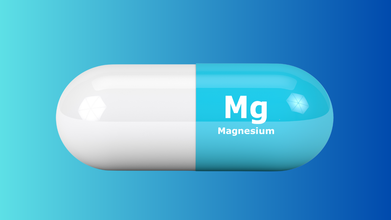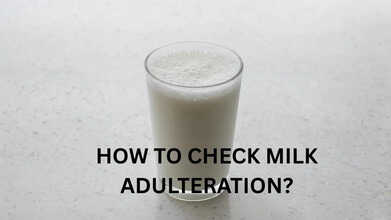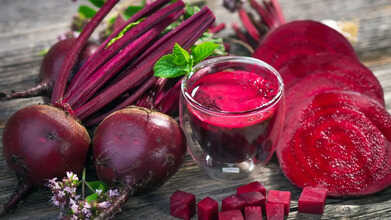- Health Conditions A-Z
- Health & Wellness
- Nutrition
- Fitness
- Health News
- Ayurveda
- Videos
- Medicine A-Z
- Parenting
- Web Stories
Can Hot Drinks Really Help You Cool Down? Science Says Yes

Credits: Canva
I was just at a café with a friend last week, and she deliberated over the menu, glancing longingly at the hot chocolate part. "I wish I could have one," she sighed, "but it's 40 degrees outside, won't it make me hotter instead?" Her problem made me stop and think. We've always been led to believe that cold beverages are the best bet on hot days, but her craving piqued my interest. Might there really be a good reason she should have that hot chocolate, yes, even in the blistering heat?
It turns out science may have her back. When the mercury goes up and the sun beats down, most of us reach for cool, soothing beverages- ice water, lemonade, or an iced coffee. The idea of sipping something hot during a heat wave is counterintuitive. But in many countries such as Bangladesh, India, Japan, and Saudi Arabia, it's nothing unusual for individuals to drink hot drinks even during the heat of the summer. In fact, traditional Chinese medicine even prescribes that certain teas have a cooling effect on the body, even if they're consumed hot. So can hot drinks actually cool you down when the weather gets really hot?
It happens that the science behind this will amaze you.
How Do Hot Drinks Have A Cooling Effect?
At first it appears totally irrational—harking back a cup of hot on a scorching hot day would probably make you hotter, right? Well, not precisely. When we consume something warmer than the temperature of our bodies, we are, naturally, going to initially feel a boost in heat. But our bodies are highly adjusted to keep our internal temperature stable, a process labeled as thermoregulation. That's where things get fascinating.
Hot drinks stimulate a specific receptor in our nerves called TRPV1. TRPV1 is the receptor for heat and alerts the body to cool down. Therefore, whenever we consume a hot drink, our body responds by initiating a cooling response- sweating but sweat is not only a pesky side effect of having a hot drink it is also essential to the survival of the body in hot climates. As sweat evaporates from the skin, it takes heat with it and cools the body. The secret to this method is having a breeze or air flow to facilitate that sweat evaporating effectively.
This is the reason that on a dry but hot day, sipping a hot drink and sweating will actually cool your body down, as long as there is sufficient airflow to allow for evaporation.
Humidity vs. Dry Heat
Though hot drinks can actually chill you down, there is an important caveat here—the humidity index. Under dry heat, evaporation works better, enabling the sweat to cool you down quicker. Under conditions of high humidity, though, the air will be filled with moisture, hence it is not as easy for sweat to evaporate. For such a weather, hot beverages might not act as coolers, and on the contrary, they might leave you worse.
A 2012 study published in Acta Physiologica examined the effects of hot drinks on cyclists in a dry, low-humidity environment. The researchers found that when the cyclists consumed hot drinks, they sweated more, and their body temperature dropped due to efficient evaporation. This study supports the idea that in the right conditions namely, dry heat, a hot beverage can provide a temporary cooling effect.
In contrast, if we consume something cold, our body temperature decreases, and thus the brain sends a message that it should decrease sweating in an effort to get back to homeostasis. This is the reason why cold beverages give an instantaneous cooling sensation but are perhaps less effective at assisting your body to control temperature in the long run, particularly in humid environments.
Hydration is Key to Sweating
Aside from inducing sweating, hot beverages can also assist in hydration—a very important part of cooling off. Although cold drinks are more commonly linked with hydration, the truth is that consuming hot beverages can be equally as hydrating as water, particularly when had in moderation.
Keeping yourself well-hydrated is important so that your body can sweat efficiently. Without sufficient fluids, your body will not be able to generate the sweat needed for cooling. Indeed, in certain instances, having something hot, such as tea, might even aid in replenishing lost fluids and electrolytes when sweating. Tea consumers who use additives such as sugar, salt, or cream are also consuming extra electrolytes—much like you would obtain from sports beverages.
What Role Electrolytes and Salt Play?
Electrolytes are necessary to keep your body's fluids in balance, and they also play a major role in cooling you down when the weather is hot. When we perspire, we lose sodium and potassium electrolytes, and if these are not replenished, it can weaken the body's capacity to regulate temperature. For this reason, some experts advise drinking fluids like hot tea with sugar or salt added to assist in replenishing electrolytes.
Research from a 2017 study published in Safety and Health at Work found that outdoor workers, particularly those in high-heat environments, often prefer cold drinks but avoid them due to the belief that cold beverages might shock their system. As a result, they tend to drink less overall and are at risk of dehydration. This highlights the importance of staying hydrated, regardless of whether you’re drinking hot or cold beverages.
It's also to be noted that the consumption of hot drinks during hot climates isn't particular to some geographical locations; it's actually an entrenched tradition among several cultures around the globe. It's for instance common to take hot tea or coffee during summers in the Middle East and portions of Asia. Not just that, it assists in cooling down the body as well, and it also happens to be an experience many like to relish.
Conventional knowledge in nations such as India tends to promote the consumption of hot chai as a means of balancing the body's internal temperature. Indeed, in certain cultures, it is believed that the intake of hot drinks during hot days will balance the body's internal heat, restoring comfort and harmony.
Why You Should Drink What Works for You?
Ultimately, the idea of sipping hot beverages to cool down is scientifically supported- provided the circumstances are right. The cooling action is largely because of the sweating response of the body, which, in turn, cools the body down. Nevertheless, it should be noted that this action is most effective in dry heat, where sweat can evaporate efficiently. In humid environments, you may find cold beverages provide a faster and more perceptible cooling sensation.
In the end, whether you like hot or cold drinks in the heat, hydration is the most critical component of keeping your body's temperature regulation intact. With hotter summers and shifting climate patterns, the science of hot drinks and cooling might be more pertinent than ever.
5 Surprising Hot Drinks That Might Actually Help You Cool Down
While the idea of sipping something hot on a blazing day sounds counterproductive, certain traditional beverages are designed to support your body’s natural cooling mechanisms. Here are five hot drinks from around the world that may help your body beat the heat:
1. Masala Chai
Often consumed piping hot in the peak of summer, masala chai isn't just about the comforting blend of spices. The heat triggers sweat production, and when that sweat evaporates, it cools your body down. The added spices like ginger and cardamom also help in digestion and hydration.
2. Mint Tea
Served hot even in desert climates, mint tea is both soothing and cooling. Mint leaves contain menthol, which tricks the brain into feeling cool, and the warm liquid encourages perspiration, assisting in thermoregulation.
3. Ginger Tea
Used in traditional Chinese medicine, ginger tea is said to balance internal heat and cold. It boosts circulation and supports gentle perspiration, which helps regulate internal temperature—especially when consumed in dry climates.
4. Hot Barley Tea
Known as mugicha in Japan and bori-cha in Korea, this caffeine-free roasted barley tea is served hot or cold. When hot, it encourages mild sweating and supports detoxification, helping you cool off from the inside out.
5. Herbal Infusions with Lemon Balm or Chamomile
Popular in European households, these herbal teas calm the nervous system and promote sweating in a gentle, regulated way. They're ideal for a warm summer evening when you want to wind down and beat the residual heat.
Each of these drinks comes from cultures that have long endured hot, dry climates and their time-tested practices show that sometimes, the smartest way to cool down is by warming up first.
Why Magnesium Matters More Than You Think

Credits: Canva
Magnesium supplements are everywhere. Whether you see it on pharmacy shelves or wellness blogs and social media where influencers who swear by them. You’ve probably heard someone claim that a daily magnesium tablet can help you sleep better, ease muscle cramps, or boost your mood. But do you actually need one, or is this just another wellness trend gone too far?
What Is Magnesium and Why Do We Need It?
Magnesium is an essential mineral that plays a crucial role in over 300 biochemical reactions in the body. It helps regulate muscle and nerve function, supports a healthy immune system, builds protein, maintains blood sugar and blood pressure levels, and aids in energy production.
Because the body doesn’t produce magnesium on its own, it must come from external sources such as food or supplements. The recommended daily intake varies: 310–420 mg for adults and 30–410 mg for children, depending on age and sex.
The good news? A balanced diet can easily meet these requirements. Magnesium-rich foods include nuts and seeds, leafy green vegetables, legumes, seafood, whole grains, and meat. Even dark chocolate can help, 100 grams of dark chocolate contains around 146 mg of magnesium.
Who Is at Risk of Magnesium Deficiency?
Most people get enough magnesium from food, but certain groups are more vulnerable to deficiency. These include people with gastrointestinal disorders such as Crohn’s disease or coeliac disease, those with type 2 diabetes, people who consume excessive alcohol, and older adults.
If you’re low on magnesium, you might notice symptoms such as muscle twitches, spasms, fatigue, low appetite, nausea, or an irregular heartbeat. However, the only way to confirm a deficiency is through a blood test prescribed by your doctor, which, in most cases, is covered by Medicare.
Can Magnesium Supplements Really Help?
Magnesium supplements are often promoted as a solution for muscle cramps, migraines, and insomnia. But do they actually work?
While magnesium deficiency can lead to cramps, most cases of muscle cramps are not due to low magnesium. Research shows limited evidence that supplements prevent cramps, especially in older adults.
The link between magnesium and better sleep is also unclear. Some studies found it helped people fall asleep faster, while others found no significant difference.
When it comes to migraines, evidence is stronger. Studies suggest that taking 122–600 mg of magnesium daily for 4–24 weeks may reduce the frequency and severity of migraines in some people.
Are Magnesium Supplements Safe?
In general, magnesium supplements are safe when taken in the recommended amounts. However, too much can lead to nausea, abdominal cramps, and diarrhea, because magnesium draws water into the intestines.
Taking extremely large doses (around 5,000 mg daily) can cause magnesium toxicity, which is dangerous. Always check with your doctor before starting supplements, especially if you take other medications.
Different Forms and What to Watch Out For
Magnesium is available in tablets, powders, and even topical forms like creams and bath salts. While these skin-based products may raise magnesium levels slightly, they’re less effective than oral supplements or food sources.
When buying supplements, check the label carefully. Most tablets contain 150–350 mg of magnesium, but formulations vary widely. Some also include additional nutrients like vitamins B6, C, or D, and minerals like calcium or manganese.
Be cautious with vitamin B6, high intake can cause nerve damage over time. If you already take a multivitamin containing B6, avoid magnesium supplements that also include it.
Think Your Milk Is Fresh? Simple Ways To Spot Adulteration At Home

Credits: Canva
Milk is one of the most common items found in every household and is considered a wholesome food packed with calcium, protein, and vitamin D.
It plays an important role in maintaining strong bones, building muscles, and supporting overall health. Because of its nutritional richness, milk is often called a complete food. However, it is essential to ensure that the milk you consume is pure and free from adulteration. Contaminated or diluted milk can lose its nutritional value and even harm your health. Fortunately, there are simple methods you can try at home to find out whether your milk is pure or adulterated.
What Is Milk Adulteration?
Food adulteration is the intentional act of reducing the quality of food by mixing or replacing it with inferior substances, or by removing essential components. The same applies to milk. While contamination of food can happen accidentally during storage, transport, or distribution, adulteration is done deliberately for profit.
Milk adulteration involves adding materials such as water, urea, detergent, or other chemicals to increase volume or extend shelf life. This practice reduces the nutritional value and can pose serious health risks to consumers.
How To Check Milk Adulteration at Home
There are a few simple ways to check for adulteration using common items at home:
- Water Test: Pour a small amount of milk onto a slanted surface. Pure milk flows slowly, leaving a white trail, while milk mixed with water flows quickly and leaves little or no mark.
- Detergent Test: Shake equal parts of milk and water. Pure milk forms a light foam, whereas adulterated milk creates thick, soapy froth.
- Starch Test: Add a few drops of iodine solution to the milk. If it turns blue, starch has been added.
- Urea Test: Mix a small amount of milk with soybean powder and dip red litmus paper into it. If the paper turns blue, it indicates the presence of urea.
What Happens When You Consume Adulterated Milk
Regularly drinking adulterated milk can cause several health issues from short-term stomach discomfort to severe, long-term illnesses. The exact effects depend on what substance has been added, ranging from diluted water to harmful chemicals.
Immediate Health Effects
- Digestive problems: Contaminants like urea, detergent, or unclean water can cause nausea, vomiting, diarrhea, and stomach cramps.
- Irritation and burning: Strong alkaline substances such as caustic soda may burn the mouth, throat, and digestive tract, damaging body tissues.
- Allergic reactions: Some chemical additives and impurities can trigger allergies, leading to rashes, itching, or breathing difficulty.
Long-Term Health Consequences
- Kidney damage: Chemicals like urea overwork the kidneys, increasing the risk of long-term damage or kidney failure.
- Liver problems: Preservatives such as formalin (formaldehyde) used to prolong milk’s freshness can harm the liver over time.
- Cancer risk: Long exposure to toxic compounds, including formalin and certain pesticides, has been linked to cancer.
- Heart disease: Artificial fats or vegetable oils added to milk can raise bad cholesterol, contributing to heart problems.
- Hormonal imbalance: Cattle injected with hormones like oxytocin can pass traces into milk, disrupting natural hormone levels in humans.
- Weakened immunity: Consuming impure milk regularly can weaken the immune system, making you more prone to infections.
- Nutritional deficiency: When milk is diluted or its nutrients are replaced with cheaper additives, it loses its health benefits. This is especially harmful for children, as it can affect their growth and development.
THIS Common Vegetable Juice Can Help Lower Your Blood Pressure Naturally

Credits: Canva
A common vegetable has been found to help reduce blood pressure in older adults, according to a new study. Beetroot juice can lower blood pressure in people aged 60 and above by targeting certain potentially harmful bacteria in the mouth. Researchers at the University of Exeter studied how younger and older adults responded to beetroot juice, which is rich in dietary nitrates. These nitrates are converted by the body into nitric oxide, a compound that relaxes and widens blood vessels, helping to lower blood pressure.
How the Study Tested Beetroot Juice on Younger and Older Adults
The study included 39 adults under the age of 30 and 36 adults in their 60s and 70s. For two weeks, each group received shots of beetroot juice. After a two-week break, during which participants used antiseptic mouthwash daily, they were given a placebo juice without nitrates for another two weeks.
Researchers analyzed the bacteria in participants’ mouths using gene sequencing. In both groups, the oral microbiome—the community of microorganisms in the mouth—changed after drinking nitrate-rich juice, though the effects were different depending on age. In older adults, there was a reduction in common bacteria that can sometimes cause infections and an increase in bacteria that support health. The older participants also showed lower blood pressure after two weeks of drinking the nitrate-rich juice.
Professor Andy Jones of the University of Exeter said, “This study shows that nitrate-rich foods can change the oral microbiome in ways that may reduce inflammation and lower blood pressure in older adults. This opens the door for larger studies to examine how lifestyle factors and biological sex affect responses to dietary nitrate supplements.”
Can A Person Drink Beet Juice While Taking Blood Pressure Medication?
It may be possible to drink beet juice while taking blood pressure medications. However, it’s important to consult a doctor before making any changes to a treatment plan for high blood pressure.
A doctor can advise whether combining beet juice with blood pressure medication could lower blood pressure too much. If this happens, a person may experience symptoms such as:
- Dizziness or lightheadedness
- Blurry vision
- Fainting
- Confusion
- Weakness or tiredness
- Headache
- Back or neck pain
- Heart palpitations
- Nausea
Low blood pressure (hypotension) can be serious. If someone experiences severe symptoms that do not improve when sitting or lying down, they should seek immediate medical attention.
Does Eating Beets Lower Blood Pressure?
Eating beets may help reduce blood pressure, but most research has focused on beet juice rather than whole beets.
Currently, there isn’t enough scientific evidence to confirm that eating beets has the same effect as drinking beet juice.
If someone wants to explore dietary changes to manage their blood pressure, it’s best to consult a doctor before making adjustments.
© 2024 Bennett, Coleman & Company Limited

